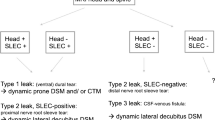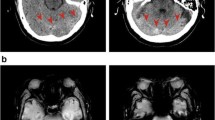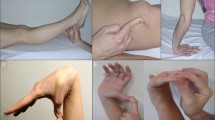Abstract
Background
We describe a case of convulsive status epilepticus caused by intracranial hypotension, a complication of spinal surgery. Intracranial hypotension (IH) is typically characterized by an orthostatic headache. There have been limited case reports describing surgery-associated IH presenting with seizures.
Methods
Case report and review of the literature.
Results
A 71-year-old woman with chronic back pain developed convulsive status epilepticus, characterized by generalized clonic seizures, immediately following scoliosis surgery. She had no history of seizures or other seizure risk factors. Despite treatment with intravenous midazolam, phenytoin, and lacosamide, seizures recurred five times over three hours. Thus, propofol and midazolam infusions were initiated. An electroencephalogram revealed burst suppression and bilateral hemispheric epileptiform discharges. Magnetic resonance imaging of the brain was consistent with IH without cortical vein thrombosis. Fluid from the surgical drains was positive for Beta-2 transferrin, consistent with cerebral spinal fluid. Her IH was likely due to an intraoperative dural tear causing status epilepticus. Over two weeks, she remained on bed rest, sedation was weaned, and phenytoin and lacosamide were tapered and discontinued. She had no further seizures.
Conclusions
IH is an under-recognized cause of seizure following the spinal or cranial surgery, lumbar puncture, or spinal anesthesia. Proposed mechanisms include traction on cortical structures, increased cerebral blood flow, and cortical irritation secondary to subdural hygromas.



Similar content being viewed by others
References
Mokri B. Spontaneous intracranial hypotension. Curr Neurol Neurosci Rep. 2001;1(2):109–17.
Kranz PG, Malinzak MD, Amrhein TJ, Gray L. Update on the diagnosis and treatment of spontaneous intracranial hypotension. Curr Pain Headache Rep. 2017;21(8):1–8.
Chaudhary N, Cooper P, Lownie SP, Ng W, Duggal N. Spontaneous intracranial hypotension: case series of rare clinical presentations. Can J Neurol Sci. 2011;38:54–8.
Schievink WI. Spontaneous spinal cerebrospinal fluid and ongoing investigations in this area. JAMA. 2006;295(19):2286–96.
Paldino M, Mogilner AY, Tenner MS. Intracranial hypotension syndrome: a comprehensive review. Neurosurg Focus. 2003;15(6):1–8.
Lin S-M, Tsou M-Y, Chan K-H, et al. Myoclonic seizure in the postanesthesia care unit after thoracic laminectomy. Anesth Analg. 2002;95(3):777.
Uchida D, Fujimoto A, Yamazoe T, Yamamoto T, Enoki H. Seizure frequency can be reduced by changing intracranial pressure: a case report of intractable epilepsy. Epilepsy Behav Case Reports 2018.
Agrawal D, Durity FA. Seizure as a manifestation of intracranial hypotension in a shunted patient. Pediatr Neurosurg. 2006;42(3):165–7.
Snyder KA, Clarke MJ, Gilbertson JR, Hocker SE. Prompt recognition and management of postoperative intracranial hypotension-associated venous congestion: a case report. Neurocrit Care. 2016;24(3):448–53.
Honig A, Eliahou R, Pikkel YY, Leker RR. Iatrogenic intracranial hypotension and cerebral venous thrombosis. J Neurol Sci. 2016;366:191–4.
Shields LBE, Johnson JR, Shields CB. Posterior reversible encephalopathy syndrome following a thoracic discectomy-induced dural leak: case report. J Neurosurg Spine. 2016;25(November):1–5.
de Carvalho M, Swash M. Neurologic complications of craniovertebral dislocation. Handb Clin Neurol. 2014;119:435–48.
Pabaney AH, Mirza FA, Syed NA, Ahsan H. Spontaneous dural tear leading to intracranial hypotension and tonsillar herniation in Marfan syndrome: a case report. BMC Neurol. 2010;10:54.
Hedna VS, Kumar A, Miller B, et al. Intracranial hypotension masquerading as nonconvulsive status epilepticus. J Neurosurg. 2014;120(3):624–7.
Funding
This manuscript received no funding.
Author information
Authors and Affiliations
Contributions
The authorship requirements have been met, and the final manuscript was approved by all authors. Dr. Gilmour was involved in the conceptual idea, data collection, and writing of the manuscript. Dr. Couillard was involved in the conceptual idea and critical revision of the manuscript. Dr. Scott was involved in the data collection.
Corresponding author
Ethics declarations
Conflicts of interest
The authors declare that they have no conflicts of interest.
Ethical approval
This manuscript adheres to ethical guidelines. No approval by an Institutional Review Board was required. Patient consent was obtained.
Additional information
Publisher's Note
Springer Nature remains neutral with regard to jurisdictional claims in published maps and institutional affiliations.
Rights and permissions
About this article
Cite this article
Gilmour, G.S., Scott, J. & Couillard, P. Leaking the Diagnosis: A Case of Convulsive Status Epilepticus Due to Intracranial Hypotension. Neurocrit Care 31, 562–566 (2019). https://doi.org/10.1007/s12028-019-00788-3
Published:
Issue Date:
DOI: https://doi.org/10.1007/s12028-019-00788-3




